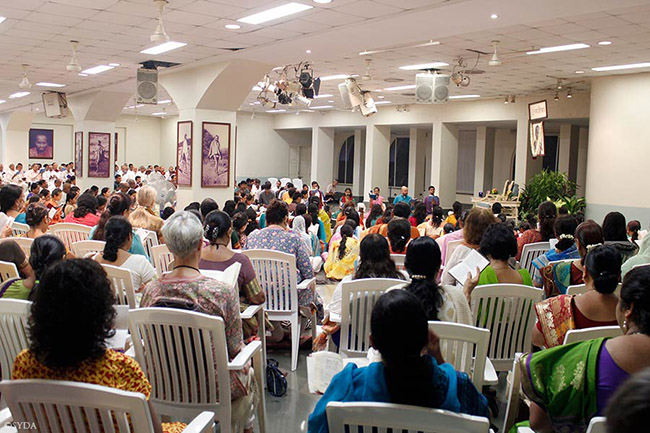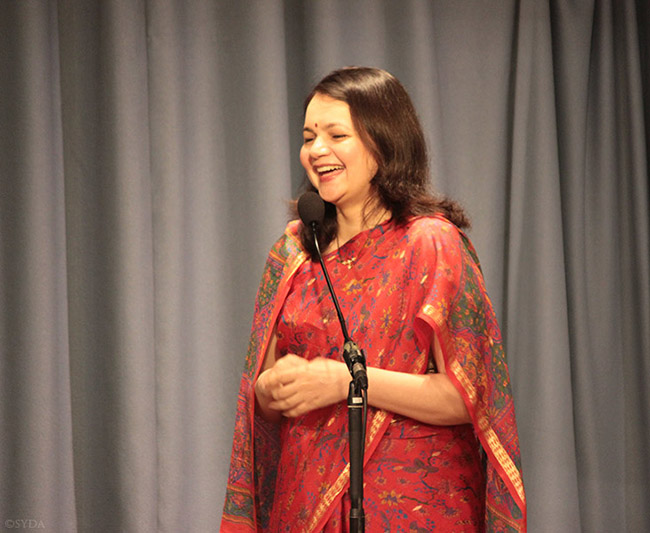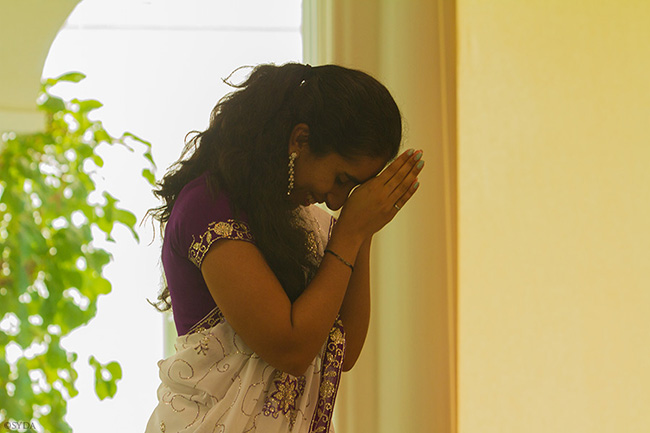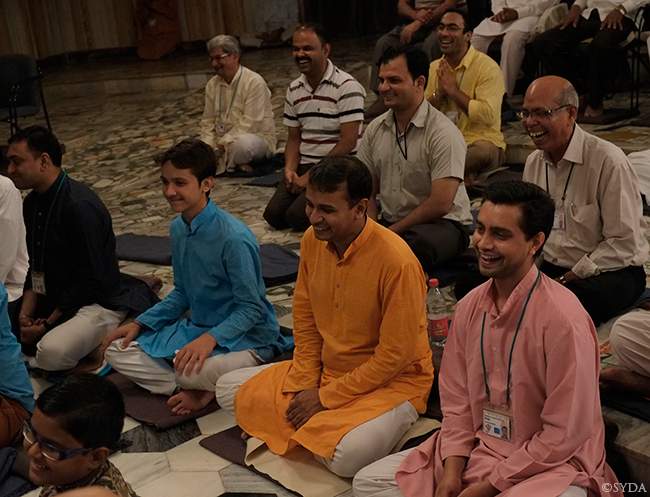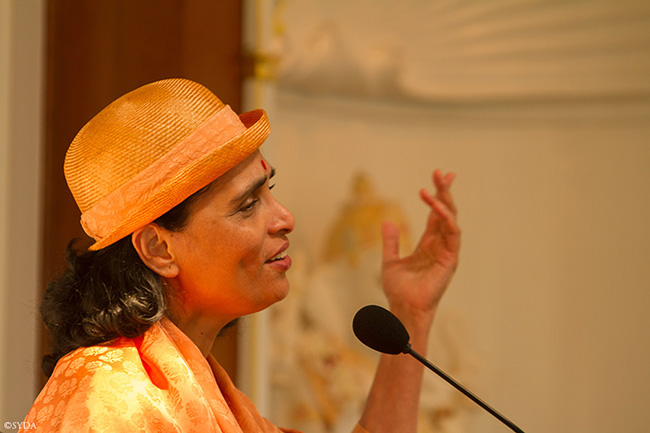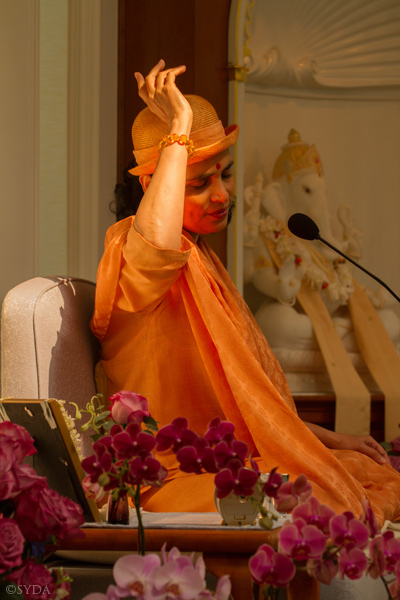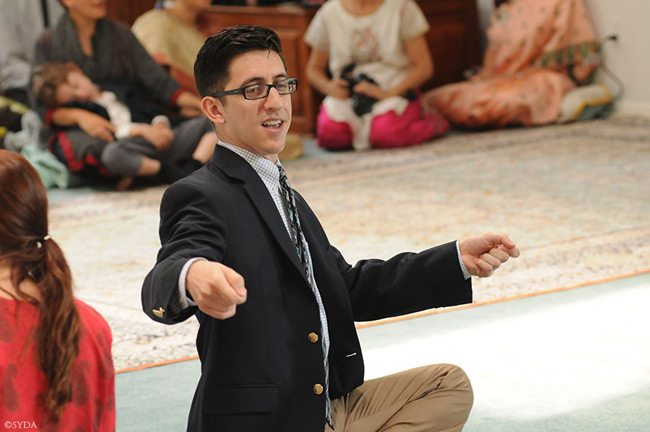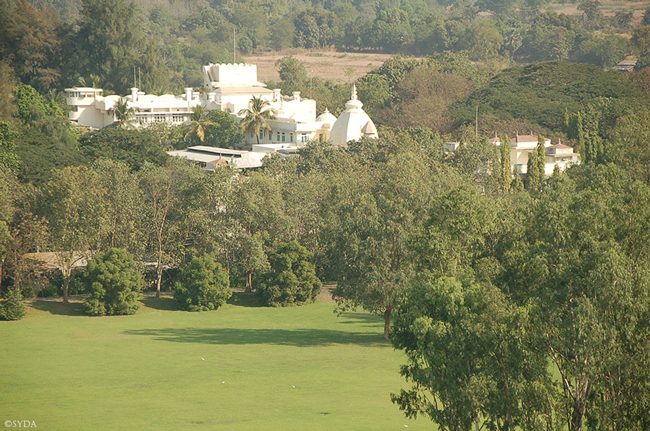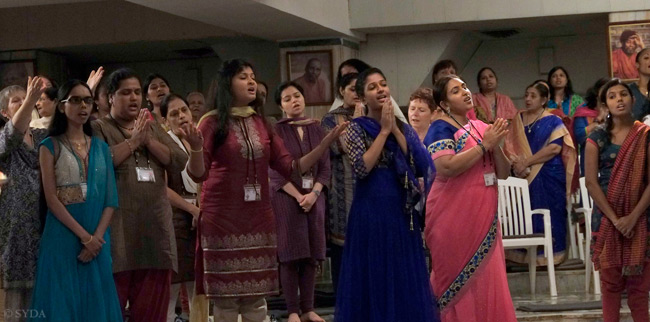Kṛpā kā Jharanā
The Waterfall of Grace
Part I
An Account of the Gurupurnima Celebration Satsang
with Gurumayi Chidvilasananda
Shree Muktananda Ashram and Gurudev Siddha Peeth
Saturday, July 12, 2014
by Swami Ishwarananda and Ami Bansal
Gurupurnima: the most auspicious occasion to honor Shri Guru for bestowing the gift of shaktipat and the knowledge of the Self. Observed for millennia throughout India, this living tradition continues to be revered and celebrated in its fullness to this day. Its integrity remains intact. Disciples worship Shri Guru and express gratitude for the Guru’s infinite grace and teachings, both in words—by reciting mantras and reading sacred texts—and by making tangible offerings.
Each July, with the approach of āshāḍha purnimā, the full moon of the month of Āshad in the Indian calendar, Siddha Yogis find ever more reason to be grateful for all we have received and continue to receive from the Gurus of the
Siddha Yoga path—Gurumayi Chidvilasananda, Baba Muktananda, and
Bhagavan Nityananda. During each Gurupurnima celebration, we pray to know what we can offer to Shri Guru that could adequately express the depth of our gratitude.
As Baba Muktananda says in Satsang with Baba, Volume One:
What could a disciple possibly give to repay the debt to the Guru? We had only one thing and that was bondage and the Guru took that away. The Guru has awakened our inner Shakti; he has transformed our inner being and has made us like himself. How can we ever repay the Guru for this?
And so it was this year, as the blessed day of Gurupurnima drew near.
We would like to share one of the ways the sweetness of the Guru-disciple relationship manifested for the benefit of all on Gurupurnima 2014.
Meghna Gautam, a Gurukula student in Gurudev Siddha Peeth, has been visiting Shree Muktananda Ashram during the month of July to offer seva. On the morning of July 11, the day before Gurupurnima, Gurumayi gave darshan to Meghna. In the darshan Meghna expressed her gratitude to Gurumayi for her grace and teachings. Meghna also shared her appreciation for the invaluable training she is receiving from the sevites in the SYDA Foundation. She said that there are so many committed sevites in Gurudev Siddha Peeth who are eager to receive such training.
Meghna said she is planning to suggest to the Trustees and Management in both the SYDA Foundation and Gurudev Siddha Peeth that trainings between sevites in Shree Muktananda Ashram and Gurudev Siddha Peeth take place on a regular basis. Meghna said that in this day and age, technology makes it possible to conduct such trainings without people having to travel, so these trainings could be held long-distance. In this way, sevites could share their knowledge and skills with one another in order to serve Gurumayi and facilitate the dissemination of her teachings to the global Siddha Yoga sangham.
Gurumayi was delighted that Meghna was expressing her heart’s desire so openly and clearly, with the intent to benefit the Siddha Yoga sangham and ensure the Siddha Yoga legacy. Gurumayi was also pleased to hear Meghna say this because over the years Gurumayi has often said it is her wish that the SYDA Foundation find ways for Siddha Yogis to participate in satsangs with Gurumayi from wherever they live.
That same evening, July 11, Gurumayi asked some of the key sevites in Shree Muktananda Ashram what time the Gurupurnima Celebration Satsang would be held in Gurudev Siddha Peeth the next day, July 12. The sevites replied that it would be held at 6:45 p.m., which would be 9:15 a.m. in Shree Muktananda Ashram. Gurumayi let them know her wish to connect with the Gurukula students and visiting sevites in Gurudev Siddha Peeth via phone during the Celebration Satsang there. Gurumayi said that she wanted to speak to the students in Gurudev Siddha Peeth and also hear from them. These sevites assured Gurumayi that it was definitely possible and that they would make it happen by working with the key sevites in Gurudev Siddha Peeth.
The sevites made a decision to wait to inform all the satsang participants in Gurudev Siddha Peeth until just before the satsang began. Small teams were organized in both Gurudev Siddha Peeth and Shree Muktananda Ashram to plan the satsang. Sevites set up an audio connection between the two Ashrams, assigned speakers and translators, arranged for musicians, and prepared the Intensive Hall in Gurudev Siddha Peeth and the Bhagavan Nityananda Temple in Shree Muktananda Ashram. Hour after hour, after night fell in New York and the sun rose in India, the sevites continued working together, so that everything would be in place for the satsang with Gurumayi to be held simultaneously in Shree Muktananda Ashram and Gurudev Siddha Peeth. They said they enjoyed having thisseva saptah—overnight in New York and throughout the day in India!
While these teams of sevites were preparing for the audio satsang, Gurukula students in Gurudev Siddha Peeth celebrated the dawning of Gurupurnima by worshiping Shri Guru in the Bhagavan Nityananda Temple and in Baba Muktananda’s Samadhi Shrine. An abhishek was performed to Bade Baba’s murti. Fragrant flowers were placed on Baba Muktananda’s Samadhi Shrine, and pujā was offered there. The Guru’s praises were sung in the morning Arati and the recitation of Shri Guru Gita.
and in Baba Muktananda’s Samadhi Shrine. An abhishek was performed to Bade Baba’s murti. Fragrant flowers were placed on Baba Muktananda’s Samadhi Shrine, and pujā was offered there. The Guru’s praises were sung in the morning Arati and the recitation of Shri Guru Gita.
On the morning of Gurupurnima, in Shree Muktananda Ashram, staff members and visiting sevites also worshiped Shri Guru by singing the morning Arati and reciting Shri Guru Gita. Later in the morning they would be participating in a Gurupurnima Celebration Satsang in Shri Nilaya in Atma Nidhi.
As evening came in India, the Gurukula students and visiting sevites in Gurudev Siddha Peeth gathered in the Intensive Hall for what they thought would be the regular scheduled Gurupurnima Celebration Satsang. It was then that the host Ami Bansal, announced that they would be participating in satsang with Gurumayi, via live audio connection with Shree Muktananda Ashram!
Ami hadn’t even finished her sentence before the hall erupted in cheers, laughter, and applause.
Participants sang out round after round of Sadgurunāth Mahārāj kī Jay, in a crescendo of joy that seemed to fill the hall with bursts of vibrant Holi colors.
Ami then asked everyone to take a moment to prepare for what was about to take place. The sounds of celebration subsided as the devotees sat silently, in awe and anticipation, entering the space of flawless quietude Gurumayi teaches about in her Message for 2014.
Meanwhile, in Shree Muktananda Ashram, Gurumayi was offering pujā to Bhagavan Nityananda in his Temple in Anugraha. As the satsang participants in Gurudev Siddha Peeth were present in the space of flawless quietude, Gurumayi offered flower after flower at Bade Baba’s feet.
With the offering of each flower, Bade Baba’s smile became more luminous and the Temple glowed with the many hues of devotion.
Once Gurumayi had completed the Guru pujā, satsangparticipants in Shree Muktananda Ashram gathered in the Bhagavan Nityananda Temple.
Then the first sounds were heard through the audio connection, and participants in Gurudev Siddha Peeth and Shree Muktananda Ashram sang together, “Sadgurunāth Mahārāj kī Jay! Sadgurunāth Mahārāj kī Jay! Sadgurunāth Mahārāj kī Jay!” As we repeated this salutation, we could feel the cohesive unity of the two Ashrams, and the outpouring of love through the phone line. Then Siddha Yoga meditation teacher Swami Ishwarananda led everyone in wishing each other Shubh Gurupurnima—an auspicious Gurupurnima!
On Gurumayi’s behalf, Swamiji welcomed all the devotees in Gurudev Siddha Peeth to the satsang.
Swamiji had visited Gurudev Siddha Peeth between November 2013 and February 2014 as Gurumayi’s Goodwill Ambassador. Swamiji’s main seva task was to convey Gurumayi’s love and blessings to everyone he met. Although Swamiji had traveled to Gurudev Siddha Peeth with this purpose, upon his return to Shree Muktananda Ashram in February, he shared in a darshan with Gurumayi that it was he who had received Gurumayi’s love through the devotion of the
Siddha Yogis he’d met.
In the Gurupurnima satsang, Swamiji shared how moved he had been by the devotion to Gurumayi expressed by the Siddha Yogis in India. He described the complete dedication of the Gurukula students to the practice of seva. He saw that they were so aware of the meaning of both sacrifice and serving selflessly, and of what a great boon it was to offer seva in the Guru’s Ashram. “Paradise on Earth.” he remembered them calling Gurudev Siddha Peeth.
It was this profound gratitude, Swamiji said, and this love between Guru and disciple which had brought us all together today, just as the love of sage Veda Vyasa’s disciples for their Guru and his great compassion for them had brought about the celebration of Gurupurnima many millennia ago.
Gurumayi then invited a visiting sevite who was part of the music ensemble to play the flute.
He played an improvisation in the majestic darbārī rāga. The melody seemed to arise from our own hearts—it was an expression, in sound, of the gratitude that everyone was offering to Gurumayi.
Then the flute melody transitioned into the melody of Shri Guru Paduka Pancakam, the Five Stanzas on the Sandals of Shri Guru. Krishna Haddad, the music conductor, invited us to join our voices with the sound of the flute for this recitation.
Om namo gurubhyo gurupadukabhyo
Om. Salutations to the Guru and the Guru’s sandals.
Shri Guru Pādukā Pancakam invokes and praises the guru-tattva, the
Guru principle, the divine power of grace that is represented by the Guru’s sandals. As we sang these verses, our hearts and minds united in the worship of Shri Guru.
Om shāntiḥ shāntiḥ shāntiḥ.
Om. Peace. Peace. Peace.
When the hymn concluded, the playful sounds of the harmonium and the rich tones of the bassoon played the melody of Om Guru, Om Guru, Om Gurudev. The rhythmic sound of the mridang added the tempo. We then offered our voices, filled with the nectar of the heart, in chanting this beautiful nāmasankirtana. Our beings swayed in the fullness of the sound. We became the sound.
Jaya Guru, Jaya Guru, Jaya Gurudev.
Then—a soft hush, as the chanting gave way to an interlude from the musicians. The flute returned with its trills and whispers. The lead chanters began singing an ālāp on “ah” that rose and ebbed and seemed to come from the deepest, most sacred space within. A wave from the conductor, and we all joined back in:
Om Gurudev!
The energy of the satsang continued to swell as we repeated over and over
Om Gurudev, Om Gurudev. At times during the chant, Gurumayi spoke to the
Siddha Yogis in Gurudev Siddha Peeth:
Gurudev Siddha Peeth, mastī se gāo.
Gurudev Siddha Peeth, chant with ecstasy.
Let the river of love flow.
We are all together.
As Om Gurudev reached a crescendo, Gurumayi called out lovingly,
“Gurudev Siddha Peeth. Gurudev Siddha Peeth. Gurudev Siddha Peeth.”




